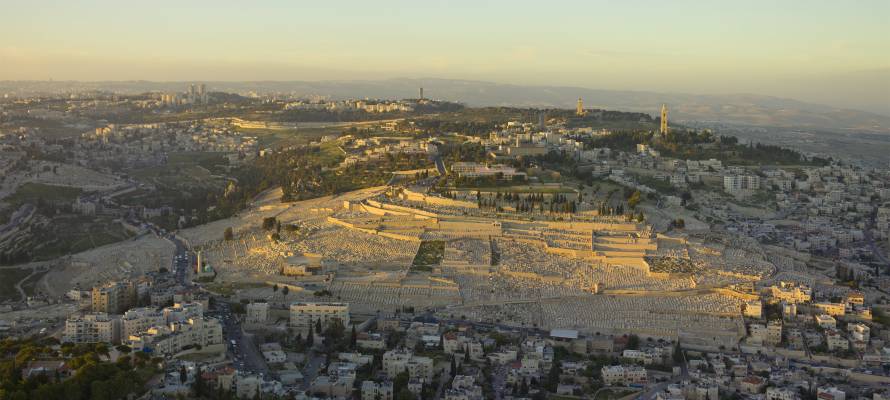King David writes, “The Mountains surround Jerusalem, just as God surrounds His people” (Psalms 125), and it seems likely that the Jewish monarch was looking at the Mount of Olives as he wrote this.
Anyone who visits the Old City of Jerusalem today can see a striking view of the Mount of Olives, with the Jewish cemetery of over 150,000 graves, standing out as key feature of the 3.5-kilometer ridge.
The Jewish cemetery on the Mount of Olives is considered by many to be the holiest Jewish cemetery in the world. Why?
The mountain is holy, and those buried there are holy.
Why is the mountain holy? When the Temple stood, the sacrifice of the Para Aduma (the Red Heifer) was done on the Mount of Olives, which – in keeping with the Biblical tradition – was “outside of the camp,” and was facing “the front of the Tent of Meeting” (Numbers 19:2-4). Also, the new month was announced by lighting a fire at its summit. Rabbinic commentators say that the olive branch that the dove brought to Noah was from the Mount of Olives. It’s interesting to note that olive trees only thrive up to the elevation of the Mount of Olives (approximately 800 meters), which was a sign to Noah that the waters had not just receded, but had receded to a particular elevation. Until the Romans sieged the city in 70 CE and cut down most of the trees, the entire mountain was covered with olive trees.
In 2 Samuel 15, we learn that King David went up the “ascent of the Olives” (in Hebrew, maaleh Zeitim). Why did he go there? He was fleeing from Jerusalem due to his son Absalom’s rebellion, and the rabbis tell us he wanted to pray in a place from where he could see Mt. Moriah, which was destined to become the place where the Holy Temple would be built. From the peak of the Mount of Olives (near where today there are over 100 Jewish families living in a neighborhood called Maaleh Zeitim), King David could see the tent he had placed on Mt. Moriah in which the Ark of the Covenant was housed until the Temple was built by David’s son, King Solomon. Visitors to the Mount of Olives may enjoy a similar, breathtaking view today of the Old City of Jerusalem and the Temple Mount.
We learn in Zachariah 14 that dramatic events will take place on the Mount of Olives connected to the Mashiach (Messiah), and there are traditions that the Prophet Zechariah was buried there, on the Mt. of Olives.
We can still see Jewish burial caves on the Mt of Olives dating back to the time when the First Temple stood, the time of the Prophet Isaiah, approximately 2,700 years ago. There are incredible burial caves and tombs from the Second Temple Period as well. Walking through the 13 different Jewish cemetery sections is like walking through Jerusalem’s Jewish history from the 16th century to the present. Visitors will be amazed to see one famous person after the next, such as the Ohr HaChaim, known for his commentary on the Torah; R. Gerson Mikitov, brother-in-law of the Ba’al Shem Tov and first Chasidic Jew in the Land of Israel in the 18th century; Rabbi Abraham Isaac HaKohen Kook, Chief Rabbi under the British Mandate; Rabbi Shlomo Goren, Chief Rabbi of the IDF in 1967, who blew the shofar on the Temple Mount; Prime Minister Menachem Begin and his wife Aliza; the Jews who were temporarily buried in the Jewish Quarter during the War of Independence; the Jews who had been buried in Gush Katif (the Jewish community in the Gaza area) and were reburied when Israel withdrew in 2005, and many more.
Remarkably, when the cemetery was under Jordanian control from 1948 to 1967, 38,000 of the then 55,000 graves were severely desecrated. When Jews were finally able to go to the cemetery after the Six Day War, tombstones were found smashed, bones were strewn around the mountain, and roads were paved over some graves. Some tombstones had been taken to use for floor tiles for Jordanian army latrines. In 1964, the PLO was founded in the hotel on the top of the Mount of Olives, and it’s important to understand that this took place before Jerusalem had control of “east Jerusalem and Judea and Samaria.
Desecration of the cemetery has continued to be a problem, even under Israel’s jurisdiction. In 2010, the International Committee for the Preservation of Har HaZeitim (ICPHH) was established to improve safety and security for the over 150,000 Jewish graves on the Mount of Olives today and for those who want to visit them. As a result, security cameras have been installed, and there is a much greater police presence in the area. For more information, see harhazeisim.org.
By: Leah Bowman
(The author, a licensed tour guide, leads inspiring tours throughout Israel, including child-friendly and bible tours. Check out her website and blog page.)
